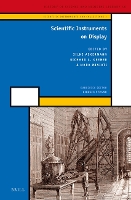


|
|
|
books
| book details |
Scientific Instruments on Display
Volume editor Silke Ackermann, Volume editor Richard Kremer, Volume editor Mara Miniati

|
| on special |
normal price: R 7 341.95
Price: R 6 974.95
|
| book description |
During their active lives, scientific instruments generally inhabit the laboratory, observatory, classroom or the field. But instruments have also lived in a wider set of venues, as objects on display. As such, they acquire new levels of meaning; their cultural functions expand. This book offers selected studies of instruments on display in museums, national fairs, universal exhibitions, patent offices, book frontispieces, theatrical stages, movie sets, and on-line collections. The authors argue that these displays, as they have changed with time, reflect changing social attitudes towards the objects themselves and toward science and its heritage. By bringing display to the center of analysis, the collection offers a new and ambitious framework for the study of scientific instruments and the material culture of science. Contributors are: Amy Ackerberg-Hastings, Silke Ackermann, Marco Beretta, Laurence Bobis, Alison Boyle, Fausto Casi, Ileana Chinnici, Suzanne Débarbat, Richard Dunn, Inga Elmqvist-Söderlund, Ingrid Jendrzejewski, Peggy A. Kidwell, Richard Kremer, Mara Miniati, Richard A. Paselk, Donata Randazzo, Steven Turner.
| product details |

Normally shipped |
Publisher | Brill
Published date | 14 Aug 2014
Language |
Format | Hardback
Pages | 231
Dimensions | 235 x 155 x 0mm (L x W x H)
Weight | 558g
ISBN | 978-9-0042-6439-7
Readership Age |
BISAC | science / scientific instruments
| other options |
|
|
|
To view the items in your trolley please sign in.
| sign in |
|
|
|
| specials |
|
Look around you is anything real or normal any more? News, images and videos created by AI are everywhere.
|
This first comprehensive biography of Cecil Rhodes in a generation illuminates Rhodes’s vision for the expansion of imperialism in southern Africa, connecting politics and industry to internal development, and examines how this fueled a lasting, white-dominated colonial society.
|
|
|
|
|
|